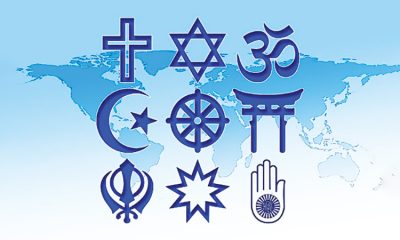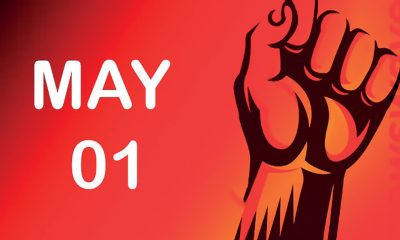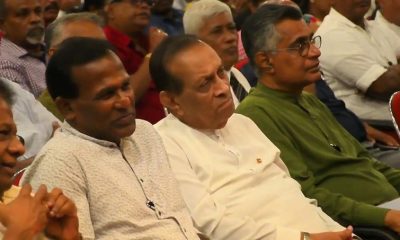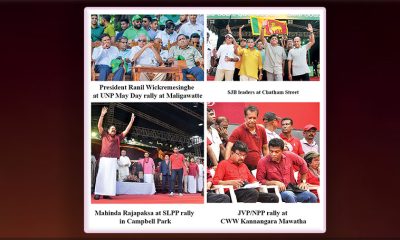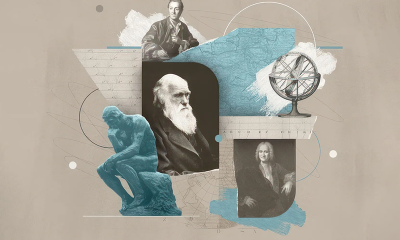Features
Upsurge of religious despotism in lanka
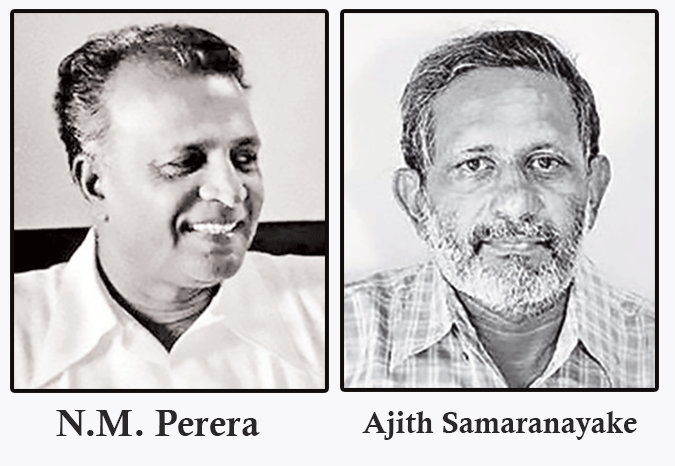
Can the jvp withstand Sinhala-Buddhist racism? N.M.’s heritage
by Kumar David
“Fascism is a religion. The 20th century will be known as the Century of Fascism.” – Benito Mussolini
We are predominantly a Buddhist country so let me ask outright; am I be allowed to say in public that I think this or that aspect of the Buddha’s teaching is wrong? I have in mind, for example, concepts associated with rebirth. Some say that it is not an essential part of the philosophy but that’s not the point. The point is this. Will I be permitted to say in public without being dragged off by the police (incited by an intolerant public), beaten and locked up, that, for example, the Buddha’s concept of rebirth is absurd and irrational? Easter is the cardinal event of the Christian faith where Christ defeated death and enthroned the victory of good over evil. Well I don’t think that a man can rise from the dead after three days of entombment. And the Christian belief in Virgin Birth, in the days before in-vitro, is patently a blunder. The relationship between Mary Magdalene and Jesus and whether the former bred progeny is controversial to some Christians but widely discussed in other jurisdictions. Muslim abhorrence of pork was not originally of religious significance; it’s a hygienic objection. The pig is a faeces-eating scavenger.
The point is that all these are perfectly serious critiques of aspects of religious philosophy, and not to be brushed aside. To be absolutely clear, let me repeat, I am not asking whether these views are right or wrong or whether you agree or not. I only ask, am I allowed to say all this? None of it can be discussed if expressing it entails being dragged off by fascistic policemen, prompted by intolerant mobs. The way things are shaping up it certainly looks like that. Fortunately, the three-million gods of Hinduism don’t care a hoot what you say. Krishna blithely stole the clothes of bathing damsels and Draupadi effortlessly laid five brothers. So, there’s somebody on my side; or is saying this sacrilegious too? Sigh!
Religion, right-wing populism and corruption
Will the proposed (semi-fascist) Sri Lankan legislation protect the right to atheism? Atheists argue that “religion is the opium of the masses” meaning that it is a soporific to lull people into accepting the injustices of this world (instead of rising up) with false promises of greater glory in the next. It’s a façade to safeguard the wealth and privileges of the “churches” of all religious denominations, enhance the powers rulers of the State and protect wealth (in the modern instance owners of capital). This is a valid critique of religion but how can one discuss it if one cannot utter it?
The CID is after stand-up comedian Natasha Edirisooriya for inflaming religious discord in her gig Fool’s Pride (Modabimanaya). She offended by her reference to ‘Suddhodanage podi eka (Suddodana’s little one), a reference to Siddhartha before he became Buddha. I have watched the entirety of the show on YouTube and I think it is not of much artistic merit. Like similar shows in the US it’s a show filled with sexual innuendo. The reference to Siddhartha is fleeting and best ignored; but religious zealots are inflamed. Religious extremism in Lanka is on the rise and has become as intolerant as in the Middle East and other theocracies. Religious fascism is on the march.
Ms Edirisooriya I understand was apprehended in the departure lounge of the Airport. And you know what! The VIP lounge at the airport is a den of thieves that would give the forty bandits who accosted Ali Baba pause. Political racketeers, ruling party sycophants and riff-raff aligned with the Royal Family infest it. No policeman or customs officer will dare confront these misbegotten sons and daughters of political felons. Amnesty International has quite rightly condemned Edirisooriya’s arrest as a flagrant violation of the freedom of speech.
The point is not whether one likes or dislikes her show, nor whether it is classy or stupid. The point for heaven’s sake is whether the woman should be dragged off and locked up when some stupid Minister or State Minister wants to play to the gallery, or the cops enjoy a bout of fascism, or the judiciary is as spineless as a leafy gourd, or President RW’s claims of liberalism turn fake. The point is that the bloody woman has every right to do her thing on stage limited only by the laws of slander PREVIOUSLY enacted by parliament.
The truth is that Sinhala-Buddhist society lives in tutelage to its own clergy. Monks preach racism and religious intolerance as a matter of course. They fear that liberalism is undermining their hold on their followers. I will change my mind on this point when I see the police drag off a monk and haul him up before a judge. (Was a first such arrest made just before Poson?). Unfortunately though in the end I have no choice but to concede that it is the people themselves, the electorate, that is blinkered.
Now a few words about that “Christian” nut Jerome Fernando. Are the things he has uttered offensive to thin-skinned religious diehards? I think yes, but not criminal. For heaven’s sake what’s criminal about saying the Buddha was in search of Enlightenment while Jesus called himself the “The Light of the World” and therefore, in JF’s mindset, the former was in search of the latter? Leaving aside JF’s rank ignorance of historical chronology, I think the fellow is a nut worth only a good laugh.
NM’s unexpected relevance
There is however a more serious concern relating to right-wing Sinhala-Buddhist populism that has raised its head. My readers are probably fed up with my bitter criticisms of the NPP-JVP for not publishing its development programme. Recently I have also been critical of its programmatic blindness on the national question (the minority issue). A particularly dangerous trend is when I hear Sinhala-Buddhist (SB) activists say: “If the JVP makes concessions to the Tamils and Muslims such as devolution or land rights it will face a backlash in its own SB backyard vote base.
The base will turn away” (the critics are not specific whether to RW, Sajith or someone else). The argument is credible and the response of the minorities is foreseeable. They will vote for their own communal parties at home, and outside their areas of domicile they will vote for right-wing candidates. Therefore, the bane of this nation, the racial divide between Sinhala Buddhism and Tamils-Muslims, will be aggravated. And this time if it happens, it will be on the watch of the Left, so the NPP-JVP will have nobody but itself to blame.
Ajith Samaranayake in one of his more inspired essays called NM “The best Prime Minister Lanka never had”. Looking back over the last 80 years this is perhaps far truer than Ajith foresaw. Had NM been PM/President (head of state) he would never have stood by and permitted the carnage that JR provoked and encouraged in the 1980s, SWRD invoked in 1959 and Mrs B allowed on the plantations to happen.
“The Role of the Individual in History” is the title of Plekhanov’s famous treatise, and indeed the Role of leaders great and small can be decisive, Gandhi, Lee Kuan Yew, Mandela and Jacinda Arden for example. And rooting out the ethnic cancer would have fundamentally changed the miserable history of this country. If NM had been Head of State, he would not have permitted the malignancy to endure. Lee had the advantage of universally enforced English and eventually a much stronger economy. But the personal character of the head of state is also profoundly important. NM, if he was Head of State in 1958 or 1983, would have firmly dispersed racist mobs, arsonists and rapists.
The legacy of Samasamajism
After its golden age of opposition to the infamous disenfranchisement of plantation Tamil workers and opposition to Sinhala Only, the Samasamaja movement did make blunders. Oh yes that’s true. At the same time there’s no denying that Samasamajists are not racists; racism invokes revulsion in their innermost core. Many are the racists who after a brief sojourn with Samasamajism went their way to terrain more agreeable to their mindset. The challenge today is whether the “revolutionary-socialist and Marxist” JVP measures up to the standards of international socialism? Will it stand against an SB wave or will it capitulate? And if it yields to racism how will it explain itself to international socialism; to the heritage of Marx, Rosa, Mao and Che? If you raise an eyebrow at the inclusion of Mao in this list, whatever Mao’s other faults he was not a racist.
Mind you as a scholar NM is no second to Lee who shone during his Cambridge years. NM was Harold Laski’s star portage at LSE, double doctor and constitutional commentator par-excellence in the Ceylon/Lanka Parliament. Who wins the prize? On scholarly merit NM; on national achievement Lee of course. (Singapore’s present Prime Minister Lee Hsien Loong, Lee Kuan Yew’s son, was Senior Wrangler in his year in the Cambridge Mathematics Tripos, the University’s most prestigious examination).
There is another point about NM that is relevant to any discourse on Lanka now. He was a quintessential social-democrat in the best traditions of the Enlightenment; but conversely, he was also a Marxist. This is the line that the JVP will have to tread in the domestic and global circumstances of these times. Sans social-democracy and commitment to change of government by democratic elections, millions will turn away. (“Aney bayai; monowa karai da dannne neha”). Furthermore, Anura Kumara, as a hypothetical Head of State, will have to address international forums such as the UN General Assembly, the World Bank and Non-Aligned Summit knowledgeably – speaking in Sinhala of course?
At the same time the nation’s youth expect radical system transforming leadership from the JVP. It’s a tough call. Can the comrades measure up to the twin challenge? I think so; NM could have had he been Head of State. It is no secret that though NM dragged us kicking and screaming into coalition with Sirima in 1964, by 1975 he was disillusioned and wanted to quit the government despite the opposition of the “golden brains” (Hector, Doric, Bernard, Colvin and Leslie). He best saw the coming electoral slaughter of the Left in 1977. He was opposed to the Chapter on Buddhism in the Republican Constitution and even told a closed session of a Party Group in Peradeniya “I don’t know how Colvin works with that woman.”
Features
The heart-friendly health minister

by Dr Gotabhya Ranasinghe
Senior Consultant Cardiologist
National Hospital Sri Lanka
When we sought a meeting with Hon Dr. Ramesh Pathirana, Minister of Health, he graciously cleared his busy schedule to accommodate us. Renowned for his attentive listening and deep understanding, Minister Pathirana is dedicated to advancing the health sector. His openness and transparency exemplify the qualities of an exemplary politician and minister.
Dr. Palitha Mahipala, the current Health Secretary, demonstrates both commendable enthusiasm and unwavering support. This combination of attributes makes him a highly compatible colleague for the esteemed Minister of Health.
Our discussion centered on a project that has been in the works for the past 30 years, one that no other minister had managed to advance.
Minister Pathirana, however, recognized the project’s significance and its potential to revolutionize care for heart patients.
The project involves the construction of a state-of-the-art facility at the premises of the National Hospital Colombo. The project’s location within the premises of the National Hospital underscores its importance and relevance to the healthcare infrastructure of the nation.
This facility will include a cardiology building and a tertiary care center, equipped with the latest technology to handle and treat all types of heart-related conditions and surgeries.
Securing funding was a major milestone for this initiative. Minister Pathirana successfully obtained approval for a $40 billion loan from the Asian Development Bank. With the funding in place, the foundation stone is scheduled to be laid in September this year, and construction will begin in January 2025.
This project guarantees a consistent and uninterrupted supply of stents and related medications for heart patients. As a result, patients will have timely access to essential medical supplies during their treatment and recovery. By securing these critical resources, the project aims to enhance patient outcomes, minimize treatment delays, and maintain the highest standards of cardiac care.
Upon its fruition, this monumental building will serve as a beacon of hope and healing, symbolizing the unwavering dedication to improving patient outcomes and fostering a healthier society.We anticipate a future marked by significant progress and positive outcomes in Sri Lanka’s cardiovascular treatment landscape within the foreseeable timeframe.
Features
A LOVING TRIBUTE TO JESUIT FR. ALOYSIUS PIERIS ON HIS 90th BIRTHDAY

by Fr. Emmanuel Fernando, OMI
Jesuit Fr. Aloysius Pieris (affectionately called Fr. Aloy) celebrated his 90th birthday on April 9, 2024 and I, as the editor of our Oblate Journal, THE MISSIONARY OBLATE had gone to press by that time. Immediately I decided to publish an article, appreciating the untiring selfless services he continues to offer for inter-Faith dialogue, the renewal of the Catholic Church, his concern for the poor and the suffering Sri Lankan masses and to me, the present writer.
It was in 1988, when I was appointed Director of the Oblate Scholastics at Ampitiya by the then Oblate Provincial Fr. Anselm Silva, that I came to know Fr. Aloy more closely. Knowing well his expertise in matters spiritual, theological, Indological and pastoral, and with the collaborative spirit of my companion-formators, our Oblate Scholastics were sent to Tulana, the Research and Encounter Centre, Kelaniya, of which he is the Founder-Director, for ‘exposure-programmes’ on matters spiritual, biblical, theological and pastoral. Some of these dimensions according to my view and that of my companion-formators, were not available at the National Seminary, Ampitiya.
Ever since that time, our Oblate formators/ accompaniers at the Oblate Scholasticate, Ampitiya , have continued to send our Oblate Scholastics to Tulana Centre for deepening their insights and convictions regarding matters needed to serve the people in today’s context. Fr. Aloy also had tried very enthusiastically with the Oblate team headed by Frs. Oswald Firth and Clement Waidyasekara to begin a Theologate, directed by the Religious Congregations in Sri Lanka, for the contextual formation/ accompaniment of their members. It should very well be a desired goal of the Leaders / Provincials of the Religious Congregations.
Besides being a formator/accompanier at the Oblate Scholasticate, I was entrusted also with the task of editing and publishing our Oblate journal, ‘The Missionary Oblate’. To maintain the quality of the journal I continue to depend on Fr. Aloy for his thought-provoking and stimulating articles on Biblical Spirituality, Biblical Theology and Ecclesiology. I am very grateful to him for his generous assistance. Of late, his writings on renewal of the Church, initiated by Pope St. John XX111 and continued by Pope Francis through the Synodal path, published in our Oblate journal, enable our readers to focus their attention also on the needed renewal in the Catholic Church in Sri Lanka. Fr. Aloy appreciated very much the Synodal path adopted by the Jesuit Pope Francis for the renewal of the Church, rooted very much on prayerful discernment. In my Religious and presbyteral life, Fr.Aloy continues to be my spiritual animator / guide and ongoing formator / acccompanier.
Fr. Aloysius Pieris, BA Hons (Lond), LPh (SHC, India), STL (PFT, Naples), PhD (SLU/VC), ThD (Tilburg), D.Ltt (KU), has been one of the eminent Asian theologians well recognized internationally and one who has lectured and held visiting chairs in many universities both in the West and in the East. Many members of Religious Congregations from Asian countries have benefited from his lectures and guidance in the East Asian Pastoral Institute (EAPI) in Manila, Philippines. He had been a Theologian consulted by the Federation of Asian Bishops’ Conferences for many years. During his professorship at the Gregorian University in Rome, he was called to be a member of a special group of advisers on other religions consulted by Pope Paul VI.
Fr. Aloy is the author of more than 30 books and well over 500 Research Papers. Some of his books and articles have been translated and published in several countries. Among those books, one can find the following: 1) The Genesis of an Asian Theology of Liberation (An Autobiographical Excursus on the Art of Theologising in Asia, 2) An Asian Theology of Liberation, 3) Providential Timeliness of Vatican 11 (a long-overdue halt to a scandalous millennium, 4) Give Vatican 11 a chance, 5) Leadership in the Church, 6) Relishing our faith in working for justice (Themes for study and discussion), 7) A Message meant mainly, not exclusively for Jesuits (Background information necessary for helping Francis renew the Church), 8) Lent in Lanka (Reflections and Resolutions, 9) Love meets wisdom (A Christian Experience of Buddhism, 10) Fire and Water 11) God’s Reign for God’s poor, 12) Our Unhiddden Agenda (How we Jesuits work, pray and form our men). He is also the Editor of two journals, Vagdevi, Journal of Religious Reflection and Dialogue, New Series.
Fr. Aloy has a BA in Pali and Sanskrit from the University of London and a Ph.D in Buddhist Philosophy from the University of Sri Lankan, Vidyodaya Campus. On Nov. 23, 2019, he was awarded the prestigious honorary Doctorate of Literature (D.Litt) by the Chancellor of the University of Kelaniya, the Most Venerable Welamitiyawe Dharmakirthi Sri Kusala Dhamma Thera.
Fr. Aloy continues to be a promoter of Gospel values and virtues. Justice as a constitutive dimension of love and social concern for the downtrodden masses are very much noted in his life and work. He had very much appreciated the commitment of the late Fr. Joseph (Joe) Fernando, the National Director of the Social and Economic Centre (SEDEC) for the poor.
In Sri Lanka, a few religious Congregations – the Good Shepherd Sisters, the Christian Brothers, the Marist Brothers and the Oblates – have invited him to animate their members especially during their Provincial Congresses, Chapters and International Conferences. The mainline Christian Churches also have sought his advice and followed his seminars. I, for one, regret very much, that the Sri Lankan authorities of the Catholic Church –today’s Hierarchy—- have not sought Fr.
Aloy’s expertise for the renewal of the Catholic Church in Sri Lanka and thus have not benefited from the immense store of wisdom and insight that he can offer to our local Church while the Sri Lankan bishops who governed the Catholic church in the immediate aftermath of the Second Vatican Council (Edmund Fernando OMI, Anthony de Saram, Leo Nanayakkara OSB, Frank Marcus Fernando, Paul Perera,) visited him and consulted him on many matters. Among the Tamil Bishops, Bishop Rayappu Joseph was keeping close contact with him and Bishop J. Deogupillai hosted him and his team visiting him after the horrible Black July massacre of Tamils.
Features
A fairy tale, success or debacle

Sri Lanka-Singapore Free Trade Agreement
By Gomi Senadhira
senadhiragomi@gmail.com
“You might tell fairy tales, but the progress of a country cannot be achieved through such narratives. A country cannot be developed by making false promises. The country moved backward because of the electoral promises made by political parties throughout time. We have witnessed that the ultimate result of this is the country becoming bankrupt. Unfortunately, many segments of the population have not come to realize this yet.” – President Ranil Wickremesinghe, 2024 Budget speech
Any Sri Lankan would agree with the above words of President Wickremesinghe on the false promises our politicians and officials make and the fairy tales they narrate which bankrupted this country. So, to understand this, let’s look at one such fairy tale with lots of false promises; Ranil Wickremesinghe’s greatest achievement in the area of international trade and investment promotion during the Yahapalana period, Sri Lanka-Singapore Free Trade Agreement (SLSFTA).
It is appropriate and timely to do it now as Finance Minister Wickremesinghe has just presented to parliament a bill on the National Policy on Economic Transformation which includes the establishment of an Office for International Trade and the Sri Lanka Institute of Economics and International Trade.
Was SLSFTA a “Cleverly negotiated Free Trade Agreement” as stated by the (former) Minister of Development Strategies and International Trade Malik Samarawickrama during the Parliamentary Debate on the SLSFTA in July 2018, or a colossal blunder covered up with lies, false promises, and fairy tales? After SLSFTA was signed there were a number of fairy tales published on this agreement by the Ministry of Development Strategies and International, Institute of Policy Studies, and others.
However, for this article, I would like to limit my comments to the speech by Minister Samarawickrama during the Parliamentary Debate, and the two most important areas in the agreement which were covered up with lies, fairy tales, and false promises, namely: revenue loss for Sri Lanka and Investment from Singapore. On the other important area, “Waste products dumping” I do not want to comment here as I have written extensively on the issue.
1. The revenue loss
During the Parliamentary Debate in July 2018, Minister Samarawickrama stated “…. let me reiterate that this FTA with Singapore has been very cleverly negotiated by us…. The liberalisation programme under this FTA has been carefully designed to have the least impact on domestic industry and revenue collection. We have included all revenue sensitive items in the negative list of items which will not be subject to removal of tariff. Therefore, 97.8% revenue from Customs duty is protected. Our tariff liberalisation will take place over a period of 12-15 years! In fact, the revenue earned through tariffs on goods imported from Singapore last year was Rs. 35 billion.
The revenue loss for over the next 15 years due to the FTA is only Rs. 733 million– which when annualised, on average, is just Rs. 51 million. That is just 0.14% per year! So anyone who claims the Singapore FTA causes revenue loss to the Government cannot do basic arithmetic! Mr. Speaker, in conclusion, I call on my fellow members of this House – don’t mislead the public with baseless criticism that is not grounded in facts. Don’t look at petty politics and use these issues for your own political survival.”
I was surprised to read the minister’s speech because an article published in January 2018 in “The Straits Times“, based on information released by the Singaporean Negotiators stated, “…. With the FTA, tariff savings for Singapore exports are estimated to hit $10 million annually“.
As the annual tariff savings (that is the revenue loss for Sri Lanka) calculated by the Singaporean Negotiators, Singaporean $ 10 million (Sri Lankan rupees 1,200 million in 2018) was way above the rupees’ 733 million revenue loss for 15 years estimated by the Sri Lankan negotiators, it was clear to any observer that one of the parties to the agreement had not done the basic arithmetic!
Six years later, according to a report published by “The Morning” newspaper, speaking at the Committee on Public Finance (COPF) on 7th May 2024, Mr Samarawickrama’s chief trade negotiator K.J. Weerasinghehad had admitted “…. that forecasted revenue loss for the Government of Sri Lanka through the Singapore FTA is Rs. 450 million in 2023 and Rs. 1.3 billion in 2024.”
If these numbers are correct, as tariff liberalisation under the SLSFTA has just started, we will pass Rs 2 billion very soon. Then, the question is how Sri Lanka’s trade negotiators made such a colossal blunder. Didn’t they do their basic arithmetic? If they didn’t know how to do basic arithmetic they should have at least done their basic readings. For example, the headline of the article published in The Straits Times in January 2018 was “Singapore, Sri Lanka sign FTA, annual savings of $10m expected”.
Anyway, as Sri Lanka’s chief negotiator reiterated at the COPF meeting that “…. since 99% of the tariffs in Singapore have zero rates of duty, Sri Lanka has agreed on 80% tariff liberalisation over a period of 15 years while expecting Singapore investments to address the imbalance in trade,” let’s turn towards investment.
Investment from Singapore
In July 2018, speaking during the Parliamentary Debate on the FTA this is what Minister Malik Samarawickrama stated on investment from Singapore, “Already, thanks to this FTA, in just the past two-and-a-half months since the agreement came into effect we have received a proposal from Singapore for investment amounting to $ 14.8 billion in an oil refinery for export of petroleum products. In addition, we have proposals for a steel manufacturing plant for exports ($ 1 billion investment), flour milling plant ($ 50 million), sugar refinery ($ 200 million). This adds up to more than $ 16.05 billion in the pipeline on these projects alone.
And all of these projects will create thousands of more jobs for our people. In principle approval has already been granted by the BOI and the investors are awaiting the release of land the environmental approvals to commence the project.
I request the Opposition and those with vested interests to change their narrow-minded thinking and join us to develop our country. We must always look at what is best for the whole community, not just the few who may oppose. We owe it to our people to courageously take decisions that will change their lives for the better.”
According to the media report I quoted earlier, speaking at the Committee on Public Finance (COPF) Chief Negotiator Weerasinghe has admitted that Sri Lanka was not happy with overall Singapore investments that have come in the past few years in return for the trade liberalisation under the Singapore-Sri Lanka Free Trade Agreement. He has added that between 2021 and 2023 the total investment from Singapore had been around $162 million!
What happened to those projects worth $16 billion negotiated, thanks to the SLSFTA, in just the two-and-a-half months after the agreement came into effect and approved by the BOI? I do not know about the steel manufacturing plant for exports ($ 1 billion investment), flour milling plant ($ 50 million) and sugar refinery ($ 200 million).
However, story of the multibillion-dollar investment in the Petroleum Refinery unfolded in a manner that would qualify it as the best fairy tale with false promises presented by our politicians and the officials, prior to 2019 elections.
Though many Sri Lankans got to know, through the media which repeatedly highlighted a plethora of issues surrounding the project and the questionable credentials of the Singaporean investor, the construction work on the Mirrijiwela Oil Refinery along with the cement factory began on the24th of March 2019 with a bang and Minister Ranil Wickremesinghe and his ministers along with the foreign and local dignitaries laid the foundation stones.
That was few months before the 2019 Presidential elections. Inaugurating the construction work Prime Minister Ranil Wickremesinghe said the projects will create thousands of job opportunities in the area and surrounding districts.
The oil refinery, which was to be built over 200 acres of land, with the capacity to refine 200,000 barrels of crude oil per day, was to generate US$7 billion of exports and create 1,500 direct and 3,000 indirect jobs. The construction of the refinery was to be completed in 44 months. Four years later, in August 2023 the Cabinet of Ministers approved the proposal presented by President Ranil Wickremesinghe to cancel the agreement with the investors of the refinery as the project has not been implemented! Can they explain to the country how much money was wasted to produce that fairy tale?
It is obvious that the President, ministers, and officials had made huge blunders and had deliberately misled the public and the parliament on the revenue loss and potential investment from SLSFTA with fairy tales and false promises.
As the president himself said, a country cannot be developed by making false promises or with fairy tales and these false promises and fairy tales had bankrupted the country. “Unfortunately, many segments of the population have not come to realize this yet”.
(The writer, a specialist and an activist on trade and development issues . )


